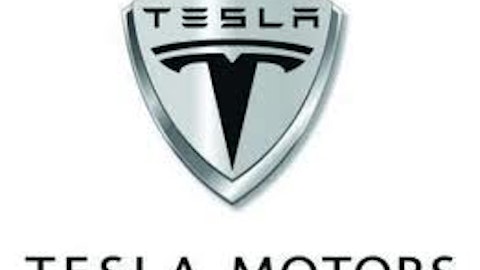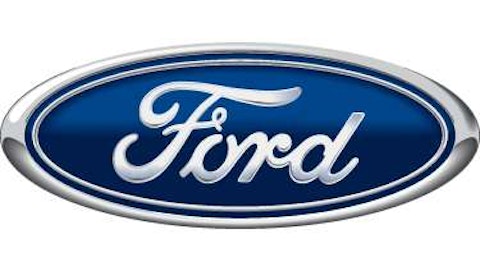The auto industry seems to be roaring, with factories operating at 95% capacity in some cases. This has led to an expected influx of new hiring within the industry, according to The Center for Automotive Research, who expects as many as an added 35,000 jobs for the full year of 2013. Vehicle sales could reach over 15.5 million for the year as well.
Two American automakers have been on a roll recently: Ford Motor Company (NYSE:F) and General Motors Company (NYSE:GM). These two companies are also both great comeback stories in their own right, so how do they stack up in comparison?
Valuations:
| P/E | Forward P/E | Price/Book | Dividend (Yield) | |
|---|---|---|---|---|
| F | 10.17 | 8.98 | 3.31 | $0.40 (2.60%) |
| GM | 11.05 | 7.35 | 1.68 | N/A (N/A) |
Ford Motor Company (NYSE:F) and General Motors Company (NYSE:GM) are trading similarly in regards to their share price relative to earnings, but Ford has the extra advantage of a dividend for investors. This dividend was also recently doubled, and Ford may become a good dividend growth story in the future, especially if the automotive industry sustains its positive momentum.


Looking at balance sheets, both auto-makers are stocked up on cash, but General Motors Company (NYSE:GM) beats out Ford Motor Company (NYSE:F). Ford’s current ratio, however, is more than double GM’s. One thing that sticks out is Ford’s debt to equity ratio. While at first glance it seems like Ford is in trouble, an investor must also consider that unlike General Motors Company (NYSE:GM), Ford has a credit arm in addition to its automotive operations.
Looking closer at the company’s balance sheet, Ford Motor Company (NYSE:F)’s amount of automotive debt at around $15 billion actually looks quite manageable in comparison to their current cash stash of almost $14 billion.
Around $91 billion of their total debt of about $107 billion is due to Ford Motor Company (NYSE:F) Credit, which many see as “good debt.” This is because this credit is generally low-risk, being either accompanied by an asset (a car that can be recovered if the debt isn’t repaid), or being debt lent to Ford automotive, which means that the company is financing itself at wholesale rates.
Ford also appears to have a stronger, more liquid balance sheet than General Motors Company (NYSE:GM), in addition to the strong financing asset it has at its disposal.


While both companies have seen revenues trending upwards, Ford’s earnings look a little better over the last five years as well.
And then there is the “disruptive innovator”
While comparing two of the more traditional car companies, another American auto-maker must also be brought up– Tesla Motors Inc (NASDAQ:TSLA).
Author Adam Hartung sees Tesla as a “classic disruptive innovator” that, while once being scoffed at by traditional auto companies, may have the last laugh.
He points out that Tesla Motors Inc (NASDAQ:TSLA) moved 100% of production and opened its second dealership in 2009 while being laughed off as a joke by GM’s Bob Lutz. Mr. Hartung also points out that while Tesla is truly creating premium all-electric automobiles, Ford and GM are set on being stuck in their old ways, which may spell trouble for them in the future. He also elaborated that even Chevy’s “electric” Volt has a gasoline engine.
He may have a point, especially since Tesla pulled in its very first profit in its most recent quarter. Tesla is also building a network of “supercharging” stations nationwide, with free recharging that takes about an hour. Electric cars are still seen as more inconvenient than traditional cars by the general public, however, so Tesla overthrowing the traditional automobile is far from a certainty, but it is definitely a real possibility in the future– especially if the price of the all-electric car comes down in the future.
CEO Elon Musk also recently announced a “battery swapping” system for Model S cars, which will enable drivers to be back on the road in as little as 90 seconds (which is much quicker than filling up a gasoline tank). Musk commented on the system, stating that
“The only decision you need to make when you come to one of our Tesla stations is, do you prefer faster or free… Our goal here was to eliminate the objections that people have. We want to show that [Tesla] can actually be more convenient than a gasoline car. Hopefully this is what convinces people that electric cars are the future.”
The “faster or free” decision Mr. Musk is referring to is the result of the $50 fee drivers will need to pay to swipe out their battery instead of waiting an hour for a free charge. So while the convenience is there, the price still isn’t– unless gasoline prices skyrocket from their current levels.
The bottom line
While Tesla and the electric vehicle may be quite a threat further down the road, in the near term the traditional automobile is safe– for now. Sales have been picking up, and Ford and GM are two American automakers that are benefiting from an increase in car sales.
Ford has a stronger balance sheet and a strong financing arm that gives it an advantage over its competitor. Ford’s dividend also adds to its credentials as a solid investment, and the growth of this dividend has been impressive– doubling during its last announced increase.
Of the two, Ford seems like the better bet.
Joseph Harry owns shares of Ford. The Motley Fool recommends Ford, General Motors, and Tesla Motors . The Motley Fool owns shares of Ford and Tesla Motors.
The article Which U.S. Automaker Is The Best Investment? originally appeared on Fool.com and is written by Joseph Harry.
Joseph is a member of The Motley Fool Blog Network — entries represent the personal opinion of the blogger and are not formally edited.
Copyright © 1995 – 2013 The Motley Fool, LLC. All rights reserved. The Motley Fool has a disclosure policy.



